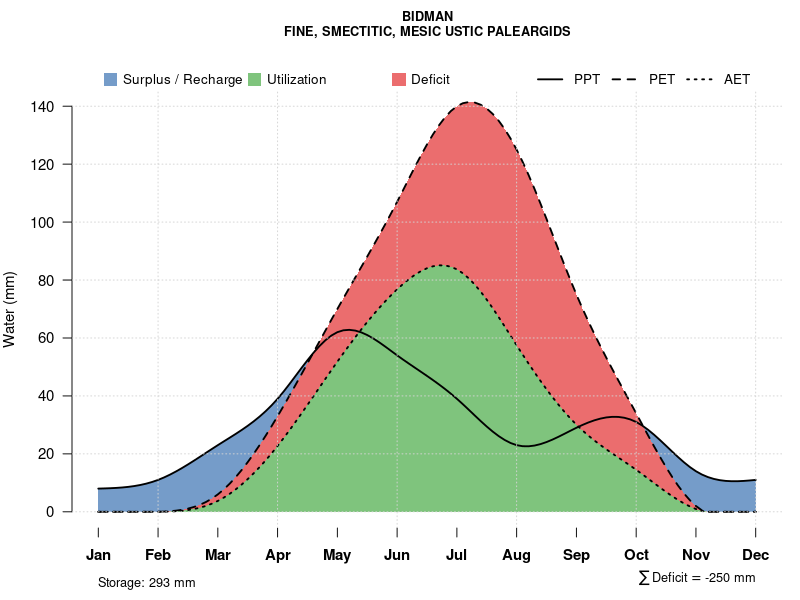| Bidman loam, 2 to 6 percent slopes | BmB | 7055 | 2768037 | 2s042 | sd019 | 1970 | 1:24000 |
Bidman-Redig complex, 2 to 9 percent slopes | BrB | 6270 | 353154 | cvh2 | sd019 | 1970 | 1:24000 |
Bidman loam, 0 to 2 percent slopes | BmA | 6009 | 2768036 | 2s041 | sd019 | 1970 | 1:24000 |
Bidman-Bone loams, 0 to 2 percent slopes | 25 | 23564 | 349305 | cqgx | wy011 | 1978 | 1:24000 |
Bidman loam, 2 to 6 percent slopes | 23 | 10919 | 2768073 | 2s042 | wy011 | 1978 | 1:24000 |
Bidman-Bone loams, 2 to 6 percent slopes | 26 | 6324 | 349306 | cqgy | wy011 | 1978 | 1:24000 |
Bidman loam, 0 to 2 percent slopes | 22 | 1603 | 2768072 | 2s041 | wy011 | 1978 | 1:24000 |
Bidman loam, 6 to 10 percent slopes | 24 | 1070 | 349304 | cqgw | wy011 | 1978 | 1:24000 |
Ulm-Bidman loams, 0 to 6 percent slopes | 214 | 183 | 349725 | cqxg | wy027 | 1993 | 1:24000 |
Bidman-Slickspots complex, 0 to 3 percent slopes | 109 | 73 | 349531 | cqq6 | wy027 | 1993 | 1:24000 |
Kyle-Shingle-Bidman association | 36 | 23787 | 152081 | 537v | wy043 | 1976 | 1:24000 |
Mughut-Bondman association | 47 | 22186 | 152092 | 5386 | wy043 | 1976 | 1:24000 |
Bidman-Ulm complex, 0 to 6 percent slopes | 5 | 26346 | 349454 | 2wlqw | wy045 | 1984 | 1:24000 |
Parmleed-Bidman loams, 2 to 10 percent slopes | 70 | 3709 | 349477 | cqng | wy045 | 1984 | 1:24000 |
Bidman loam, 0 to 6 percent slopes | 3 | 2739 | 349432 | 2v095 | wy045 | 1984 | 1:24000 |
Bidman-Bone loams, 0 to 2 percent slopes | 4 | 1317 | 349443 | cqmc | wy045 | 1984 | 1:24000 |
Bidman-Slickspots complex, 0 to 3 percent slopes | 154 | 133 | 1614839 | 1r6cl | wy045 | 1984 | 1:24000 |
Bidman-Parmleed loams, 0 to 6 percent slopes | 111 | 36035 | 349796 | 2v094 | wy605 | 1995 | 1:24000 |
Bidman-Ulm loams, 0 to 6 percent slopes | 113 | 26627 | 349798 | 2wlqv | wy605 | 1995 | 1:24000 |
Bidman loam, 0 to 6 percent slopes | 109 | 9374 | 349794 | 2v095 | wy605 | 1995 | 1:24000 |
Bidman-Parmleed loams, 6 to 15 percent slopes | 112 | 8726 | 349797 | cqzs | wy605 | 1995 | 1:24000 |
Bidman loam, loamy substratum, 0 to 6 percent slopes | 110 | 3961 | 349795 | cqzq | wy605 | 1995 | 1:24000 |
Heldt-Bidman complex, saline, 0 to 3 percent slopes | 155 | 3411 | 349842 | cr17 | wy605 | 1995 | 1:24000 |
Ulm-Bidman complex, 0 to 6 percent slopes | 257 | 1278 | 1669748 | 2yv7t | wy609 | 2006 | 1:24000 |
Briggsdale-Bidman complex, rolling | BRD | 8901 | 350815 | cs1m | wy619 | 1971 | 1:24000 |
Bidman-Ulm complex, 0 to 6 percent slopes | 114 | 14644 | 361105 | 2yrym | wy633 | 1987 | 1:24000 |
Parmleed-Bidman fine sandy loams, 3 to 15 percent slopes | 201 | 9153 | 361092 | d3r4 | wy633 | 1987 | 1:24000 |
Parmleed-Bidman association, moist, 3 to 9 percent slopes | 202 | 9092 | 361091 | d3r3 | wy633 | 1987 | 1:24000 |
Bidman, moist-Ulm loams, 0 to 6 percent slopes | 115 | 5207 | 361102 | d3rg | wy633 | 1987 | 1:24000 |
Parmleed-Bidman association, moist, 9 to 25 percent slopes | 203 | 4450 | 361090 | d3r2 | wy633 | 1987 | 1:24000 |
Bidman-Arvada fine sandy loams, 0 to 6 percent slopes | 112 | 2744 | 361103 | d3rh | wy633 | 1987 | 1:24000 |
Bidman-Arvada complex, moist, 0 to 3 percent slopes | 113 | 1471 | 361104 | d3rj | wy633 | 1987 | 1:24000 |
Ulm-Bidman complex, 0 to 6 percent slopes | 327 | 11177 | 817511 | 2ztzr | wy705 | 2003 | 1:24000 |
Bidman-Parmleed loams, 0 to 6 percent slopes | 255 | 1828 | 817510 | 2v094 | wy705 | 2003 | 1:24000 |
Bidman-Ulm complex, 0 to 6 percent slopes | 256 | 1524 | 817512 | 2yrym | wy705 | 2003 | 1:24000 |
Heldt-Bidman complex, saline, 0 to 3 percent slopes | 155 | 248 | 817540 | wfq8 | wy705 | 2003 | 1:24000 |
Parmleed-Bidman fine sandy loams, 3 to 15 percent slopes | 304 | 223 | 817571 | wfr8 | wy705 | 2003 | 1:24000 |
Ulm-Bidman complex, 0 to 6 percent slopes | 142 | 25050 | 351520 | 2yv7t | wy709 | 1983 | 1:24000 |
Ulm-Bidman loams, 0 to 6 percent slopes | 235 | 393 | 1427852 | 1jxsr | wy709 | 1983 | 1:24000 |
Bidman-Ulm loams, 0 to 6 percent slopes | 256 | 305 | 1427913 | 2wlqv | wy709 | 1983 | 1:24000 |
Bidman-Ulm complex, 0 to 6 percent slopes | 239 | 297 | 1427896 | 2wlqw | wy709 | 1983 | 1:24000 |
Parmleed-Bidman fine sandy loams, 3 to 15 percent slopes | 623 | 7533 | 1604041 | 1qv48 | wy719 | 2013 | 1:24000 |
Ulm-Bidman complex, 0 to 6 percent slopes | 609 | 7120 | 813979 | 2yv7t | wy719 | 2013 | 1:24000 |
Bidman-Parmleed loams, 0 to 6 percent slopes | 608 | 6678 | 813929 | 2v094 | wy719 | 2013 | 1:24000 |













